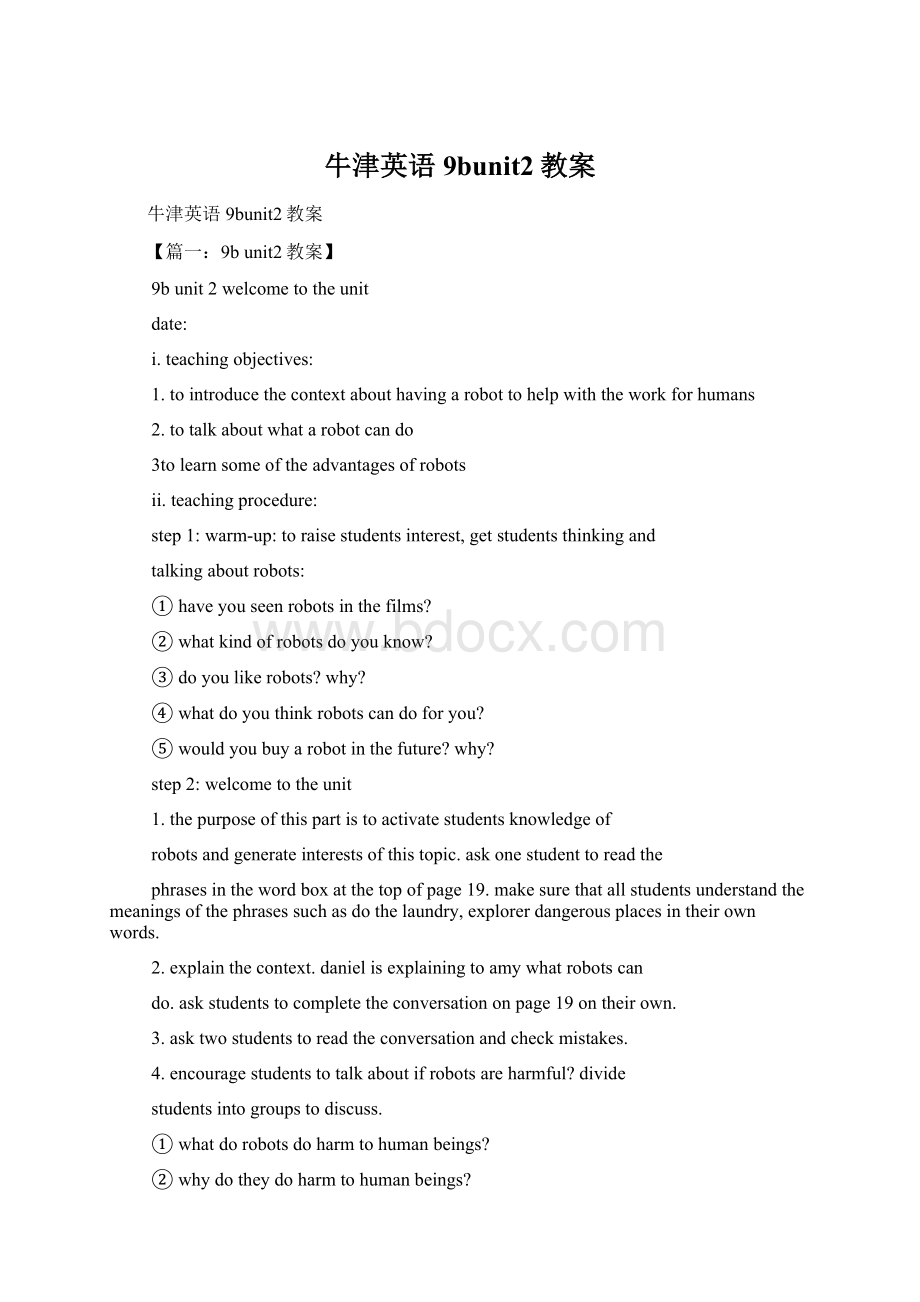牛津英语9bunit2教案.docx
《牛津英语9bunit2教案.docx》由会员分享,可在线阅读,更多相关《牛津英语9bunit2教案.docx(13页珍藏版)》请在冰豆网上搜索。

牛津英语9bunit2教案
牛津英语9bunit2教案
【篇一:
9bunit2教案】
9bunit2welcometotheunit
date:
i.teachingobjectives:
1.tointroducethecontextabouthavingarobottohelpwiththeworkforhumans
2.totalkaboutwhatarobotcando
3tolearnsomeoftheadvantagesofrobots
ii.teachingprocedure:
step1:
warm-up:
toraisestudentsinterest,getstudentsthinkingand
talkingaboutrobots:
①haveyouseenrobotsinthefilms?
②whatkindofrobotsdoyouknow?
③doyoulikerobots?
why?
④whatdoyouthinkrobotscandoforyou?
⑤wouldyoubuyarobotinthefuture?
why?
step2:
welcometotheunit
1.thepurposeofthispartistoactivatestudentsknowledgeof
robotsandgenerateinterestsofthistopic.askonestudenttoreadthe
phrasesinthewordboxatthetopofpage19.makesurethatallstudentsunderstandthemeaningsofthephrasessuchasdothelaundry,explorerdangerousplacesintheirownwords.
2.explainthecontext.danielisexplainingtoamywhatrobotscan
do.askstudentstocompletetheconversationonpage19ontheirown.
3.asktwostudentstoreadtheconversationandcheckmistakes.
4.encouragestudentstotalkaboutifrobotsareharmful?
divide
studentsintogroupstodiscuss.
①whatdorobotsdoharmtohumanbeings?
②whydotheydoharmtohumanbeings?
5.listentothetapeforthefirsttimetolearnthemainideaof
thecomicstrip.
6.listentothetapeforthesecondtimetoreadafterthetape.
7.asksomestudentstoactoutthecomicstrip.
step3:
usefulexpressions
1.complaint:
不+可数名词抱怨;可数名词抱怨的行动或话,投诉
complain:
动词:
complainto/about
2.post:
动词邮寄:
.postsomethingforsb.
iii.homework:
1.recitetheusefulvocabularyandcomicstrip.
2.completesomeexercise.
3.previewreading
(1)
教学小结:
学生基本能掌握对话,理解机器人能为人类做好多事。
要求学生进行会话,课后学生都能背诵对话。
unit2reading
(1)
date:
i.teachingobjectives:
1.tounderstandtheideaofhowrobotscanchangeourlives.
2.torecognizeandunderstandvocabularyaboutlifewithrobots.
3.toidentifythegoodpointsofowningarobot.
ii.teachingprocedure:
step1:
backgroundinformation:
arobotisanautomatedmachinethatis
programmedtoperformfunctionsjustasahumanwoulddo.step2:
readingthefirstpersontoownarobot
1.reviewthethingsthatarobotcandoinwelcometotheunit.
askstudentswhethertheybelievepeoplewilluserobotstodotheirchoresfortheminthefuture.
2.explainthecontextofthereadingpassage.danielisreadingan
articleabouthavingarobotathome.therearegoodpointsandbad
points.
3.askstudentstolistentothepassage,payingattentiontothe
pronunciation,andmakesomeofthemtoreadtheparagraphsaloud.
4.listthegoodpoints.
5.askstudentstoreadeachparagraphandputforwardquestionsif
theyhave.
step3:
languagepoints
1.thefirstonetodosth.
2.inorderto:
引导目的状语,后接动词原形,可以放在句首,或句末,否定形式inordernottodosth.:
shelistenstoenglisheverydayinordertogetgoodmarks.
=soastodo:
shelistenstoenglisheverydaysoastogetgoodmarks.
=inorderthat+从句:
shelistenstoenglisheverydayinorderthatshecangetgoodmarks.
=sothat:
shelistenstoenglisheverydaysothatshecangetgoodmarks.
3.asaresult:
因为,由于,由于。
。
。
结果,用来做结果状语
shewaslateasaresultofheavyrain.
4.nolonger:
不再,再也不,今后不再,指时间,多由于修饰某种具体状态,相当于notanylonger,其中any
longer一般放在句末。
inolongergothere.=idontgothereanylonger.
(nomore也用来表示不再,再也不,但是强调数量和程度=notanymore)theresnomorewater.=thereisnotwateranymore.
5.foranextrahour:
extra额外的,附加的
iii.homework:
1.recitetheusefulvocabularyandparagraphs.
3.previewreading
(2)
教学小结:
了解机器人如何改变我们的生活,掌握课文里的语言点和重点。
以及机器人给我们带来的好处。
9bunit2reading
(2)
date:
i.teachingobjectives:
1.toidentifythebadpointsofowningarobot.
2.toidentifytrueandfalsestatementsaboutlifewitharobot.
ii.teachingprocedure:
dictation.
step2:
readingthefirstpersontoownarobot
1.explainthecontextofthesecondpartofthereadingpassage.
danielisreadinganarticleabouthavingarobotathome.therearebadpoints.
2.askstudentstolistentothepassage,payingattentiontothe
pronunciation,andmakesomeofthemtoreadtheparagraphsaloud.
3.listthebadpoints.
①catchavirusandcausealotofproblems
②nolongerknowwhentocookandwakemr.jiangupat4inthemorning.
③findhisbreakfastinthewashingmachine,cleanshirtsinthe
dustbin,booksinthesink.
④movearoundthehouseandknockthingsover
4.askstudentstoreadeachparagraphandputforwardquestionsif
theyhave.
step3:
languagepoints
1.behappywith=besatisfied/pleasedwith
2.wakesb.up
3.intheend=atlast=finally
4.returnsth.tosb.=givesth.backtosb.
5.decidetodosth.
iii.homework:
1.recitetheusefulvocabularyandparagraphs.
2.completesomeexercise.
3.previewvocabulary
教学小结:
了解第一个拥有机器人的人以及机器人给他带来的坏处。
这一课时结实以后要求学生背诵课文。
提高学生的口语能力。
9bunit2vocabulary
date:
i.teachingobjectives:
1.tolearnthenamesofdifferentpartsofarobot.
2.todesignanidealrobot
3.towriteanarticletodescribetheidealrobot.
ii.teachingprocedure:
step1:
inweakerclasses,studentsprobablywillnotknowwhatsomeof
thewordsinpartamean.writethewordsontheblackboardandhelpthemfinishthepart.
e.g.:
whatstheuseofacamera/battery/hand/wheel/speaker?
acameratakespictures.
abatterygivesuspower.
ahandhelpspickupthings.
wheelshelpthingsmove.
wecanhearsoundthroughaspeaker.
step2:
showstudentsrobotpicturesandaskstudentswhatotherfeatures
arobotmighthave.thiswillhelpstudentswithpartb.encouragestudentstousetheirimagination.
①askstudentstolookatthepictureonpage24andanswerthequestions.
②askstudentsquestionsaccordingtothepicturesshown:
whatdoesitlooklike?
whatisthereonthehead/intheface/onbothsidesofitsbody?
howdoesitspeak?
whatistheuseofthearms/hands?
howdoesitmove?
whatkindofenergydoesithave?
step3:
explainthecontextofpartb.danieliswritinganarticleto
describehisidealrobot.havestudentsworkinpairsandcompletetheexercise.
step4:
askvolunteerstoreadthecompletedarticlefortheclass.check
formistakesandmispronunciations.
iii.homework:
1.previewgrammar1
2.completesomeexercises.
教学小结:
了解机器人的各部分零件。
以及各部分零件的用处。
帮助差一些的学生能更好的理解它们的意思,把单词写在黑板上,使他们更好的掌握。
9bunit2pronunciation
date:
i.teachingobjectives:
1.tounderstandtheuseofstressinsentences
2.torecognizethedifferentmeaningsofasentencebasedonwhere
thestressisplaced
3.tostresstherightwordsinasentence
4.tochoosethecorrectmeaningsofasentencebasedonstressed
words.
ii.teachingprocedure:
step1:
readthethreeexamplesentencesclearlyandslowlyforstudents
tolistento.askstudentstorepeatsentenceafteryoupayingattentiontothewordsthatisstressed.
step2:
playtherecordingforpartathroughonceandaskstudentsto
listencarefullytothestressedwords.
step3:
playtherecordingagainandencouragestudentstoimitatewhat
theyhear.askstudentstoreadthesentencesaloud.
step4:
explainhowthestressedwordsaffectthemeaningsofthe
sentences.
step5:
dividetheclassintopairs.askstudentstoreadoutthe
sentencestoeachother,stressingthewordsinbold.listentothesentencesasyouwalkaroundtheclass.praiseareaswherestudentsperformwell.
step6:
explainthatwhenwespeak,wecanstressdifferentwordsina
sentence.thewordswestresscanchangethemeaningsofthesentence.writeanexamplesentenceontheblackboard:
thedogatefourtinsofbeansyesterday.
①whoatefourtinsbeansyesterday?
②howmanytinsofbeansdidthedogeatyesterday?
③whatdidthedogeatfourtinsofyesterday?
④whendidthedogeatfourtinsofbeans?
step7:
readthetwosentencesinpartbaloud,stressingthewordsrobot
anddaniel.
step8:
askstudentstoreadpointsa,bandcundereachsentence.ask
【篇二:
9bunit2教案】
1
2
3
4
5
【篇三:
9bunit2教案】
welcometotheunitandcomic
i.teachingobjectives:
1.tointroducethecontextabouthavingarobottohelpwiththework
forhumans
2.totalkaboutwhatarobotcando
3.tolearnsomeoftheadvantagesofrobots
ii.teachingprocedure:
step1:
warm-up:
toraisestudents’interest,getstudentsthinkingand
talkingaboutrobots:
①haveyouseenrobotsinthefilms?
②whatkindofrobotsdoyouknow?
③doyoulikerobots?
why?
④whatdoyouthinkrobotscandoforyou?
⑤wouldyoubuyarobotinthefuture?
why?
step2:
welcometotheunit
1.thepurposeofthispartistoactivatestudent’sknowledgeof
robotsandgenerateinterestsofthistopic.askonestudenttoreadthe
phrasesinthewordboxatthetopofpage19.makesurethatall
studentsunderstandthemeaningsofthephrasessuchas‘dothelaundry,explorer
dangerousplaces’intheirownwords.
2.explainthecontext.danielisexplainingtoamywhatrobotscan
do.askstudentstocompletetheconversationonpage19ontheirown.
3.asktwostudentstoreadtheconversationandcheckmistakes.
4.(forstrongerclass)encouragestudentstotalkaboutifrobotsare
harmful?
divide
studentsintogroupstodiscuss.
①whatdorobotsdoharmtohumanbeings?
②whydotheydoharmtohumanbeings?
5.listentothetapeforthefirsttimetolearnthemainideaof
thecomicstripbyaskingsomequestions.
6.listentothetapeforthesecondtimetoreadafterthetape.
7.asksomestudentstoactoutthecomicstrip.
step3:
usefulexpressions
1.complaint:
不可数名词“抱怨”;可数名词“抱怨的行动或话,投诉”
complai